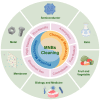Micro-Nano Bubbles: A New Field of Eco-Friendly Cleaning
- PMID: 40214526
- PMCID: PMC11990430
- DOI: 10.3390/nano15070480
Micro-Nano Bubbles: A New Field of Eco-Friendly Cleaning
Abstract
Due to increasing public awareness of environmental concerns and stricter cleaning process requirements, traditional cleaning technologies characterized by high pollution, excessive energy consumption, and substantial damage are insufficient to meet contemporary demands. There is an urgent need for efficient, low-damage, and environmentally friendly cleaning technologies. In recent years, the rapid advancement of micro-nano bubbles (MNBs), which exhibit unique physicochemical properties, have emerged as a promising solution for green cleaning applications. This review begins with an overview of the benefits of MNBs in cleaning processes, followed by an in-depth analysis of the factors influencing their cleaning effectiveness as well as the possible mechanisms involved. Additionally, the producing and application of MNBs across various cleaning scenarios are summarized. Finally, prospects for their development are discussed. Research and advancements in MNB preparation technologies are expected to boost their applicability and commercialization in a greater variety of cleaning contexts in the future.
Keywords: contaminant removal; eco-friendly technique; micro-nano bubbles; surface cleaning.
Conflict of interest statement
The authors declare no conflicts of interest.
Figures







Similar articles
-
Green Cleaning of 3D-Printed Polymeric Products by Micro-/Nano-Bubbles.Nanomaterials (Basel). 2023 Jun 5;13(11):1804. doi: 10.3390/nano13111804. Nanomaterials (Basel). 2023. PMID: 37299707 Free PMC article.
-
Research progress of micro-nano bubbles in environmental remediation: Mechanisms, preparation methods, and applications.J Environ Manage. 2025 Feb;375:124387. doi: 10.1016/j.jenvman.2025.124387. Epub 2025 Feb 3. J Environ Manage. 2025. PMID: 39904246 Review.
-
Subsurface transport behavior of micro-nano bubbles and potential applications for groundwater remediation.Int J Environ Res Public Health. 2013 Dec 30;11(1):473-86. doi: 10.3390/ijerph110100473. Int J Environ Res Public Health. 2013. PMID: 24380978 Free PMC article.
-
Co-coagulation of micro-nano bubbles (MNBs) for enhanced drinking water treatment: A study on the efficiency and mechanism of a novel cleaning process.Water Res. 2022 Nov 1;226:119245. doi: 10.1016/j.watres.2022.119245. Epub 2022 Oct 13. Water Res. 2022. PMID: 36283233
-
A critical review on the properties and applications of bulk micro and nanobubbles for the degradation of organic pollutants in wastewater treatment.Sci Total Environ. 2025 May 10;976:179310. doi: 10.1016/j.scitotenv.2025.179310. Epub 2025 Apr 7. Sci Total Environ. 2025. PMID: 40188725 Review.
Cited by
-
Emerging and Innovative Technologies for the Sanitization of Fresh Produce: Advances, Mechanisms, and Applications for Enhancing Food Safety and Quality.Foods. 2025 May 28;14(11):1924. doi: 10.3390/foods14111924. Foods. 2025. PMID: 40509452 Free PMC article. Review.
References
-
- Suryadevara B. Advances in Chemical Mechanical Planarization (CMP) Woodhead Publishing; Sawston, UK: 2016.
-
- Zhou Z., Sun W., Wu J., Chen H., Zhang F., Wang S. The Fundamental Mechanisms of Laser Cleaning Technology and Its Typical Applications in Industry. Processes. 2023;11:1445. doi: 10.3390/pr11051445. - DOI
-
- Bayoumi M.R., Abdellatif A.K. Effect of surface finish on fatigue strength. Eng. Fract. Mech. 1995;51:861–870. doi: 10.1016/0013-7944(94)00297-U. - DOI
-
- Rowan N.J. Digital technologies to unlock safe and sustainable opportunities for medical device and healthcare sectors with a focus on the combined use of digital twin and extended reality applications: A review. Sci. Total Environ. 2024;926:171672. doi: 10.1016/j.scitotenv.2024.171672. - DOI - PubMed
-
- Rowan N.J., Kremer T., McDonnell G. A review of Spaulding’s classification system for effective cleaning, disinfection and sterilization of reusable medical devices: Viewed through a modern-day lens that will inform and enable future sustainability. Sci. Total Environ. 2023;878:162976. doi: 10.1016/j.scitotenv.2023.162976. - DOI - PubMed
Publication types
Grants and funding
LinkOut - more resources
Full Text Sources

